The Peterhead Whalers
Two hundred years ago whaling was as important as the oil industry is today
Whales were not hunted for food, but for their blubber, the thick layer of fat under their skins that protected them from the freezing cold waters of the far north seas. Oil could be extracted from the blubber and used to make candles or for burning in oil lamps in the days before electric lights. Whale oil was very valuable and some whale ship owners made huge fortunes from selling the oil. It also provided a good wage for the men who crewed the ships.
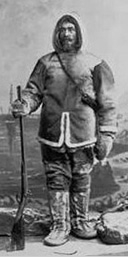 Life was very hard aboard the old whaling ships. It was always cold in the icy seas and men wore special clothes made from seal skins to keep them warm as they worked. This picture shows Captain Alexander Murray from Peterhead in his caribou skin clothes. Ordinary seamen would have worn less expensive seal skin clothes. (Information from Andrew Murray, Blackwood, South Australia).
Life was very hard aboard the old whaling ships. It was always cold in the icy seas and men wore special clothes made from seal skins to keep them warm as they worked. This picture shows Captain Alexander Murray from Peterhead in his caribou skin clothes. Ordinary seamen would have worn less expensive seal skin clothes. (Information from Andrew Murray, Blackwood, South Australia).
In the mid 1850s Peterhead had a huge fleet of more than 30 whailing ships employing over a thousand sailors. The trade also provided work for thousands of people ashore. Ship builders, rope and sail makers, and all the others who provided the ships' stores for the long voyages, butchers, bakers and candlestick makers!
The Foy
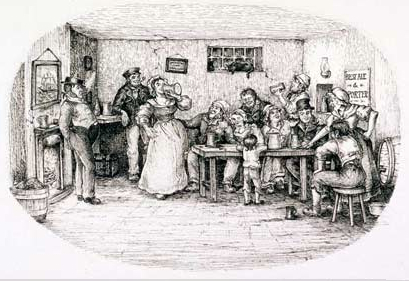
Before the fleet left port the whole town enjoyed a party called "The Foy", a tradition that was brought to Peterhead by the Dutch fishermen who used the harbour as a fishing station in the 1600s.
The ships would be away for at least six months so before they left the whole town celebrated with a party. It was called "The Foy" and was paid for by the ship owners. People of all ages enjoyed the parties in the taverns and streets around the harbour where there was dancing and singing and lots to eat and drink. The sailors' sweethearts and wives gave them ribbons for luck which the men hung from garlands high in the rigging. The men took great pride in decorating the ships and prizes were given to the "smartest ship." It must have been a splended sight when the ships set sail for the Arctic seas with flags flying and ribbons blowing in the wind!
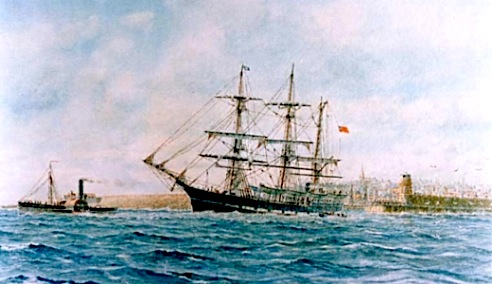
"The Hope" being towed out to sea by the harbour steam tug "Pride of Scotland." Once clear of the harbour the Captain would order his crew to set sail for the northern seas.
"The Hope" was in built in Aberdeen for Captain John Gray Junior in 1872. His grandfathers, father and two brothers were all successful whaling captains. His grandfather, Alexander Geary, served aboard "The Robert", Peterhead's first whaler in 1788 and John's older brother David was the captain of "The Windward" when the ship made her last whaling voyage from Peterhead in 1893.
A Voyage to the Whaling Grounds
The fleet left port in late February and early March. First stop was the Orkney or Shetland Isles where the Captains would sign on extra hands for the voyage. The ships then headed either north to the Greenland Sea to hunt Greenland Right Whales or west, across the Atlantic and then north into the Davis Strait to hunt Atlantic Bowhead whales. Some Captains prefered the Greenland Sea and others The Davis Strait. Some went to both.
The Whales
The Right whales and the Bowheads were very similar. They grew up to 20 metres in length and could weigh as much as 100 tons and carried huge amounts of blubber. Seals were also hunted for their blubber and thousands were killed every year by the fleets from Northern Europe and North America.
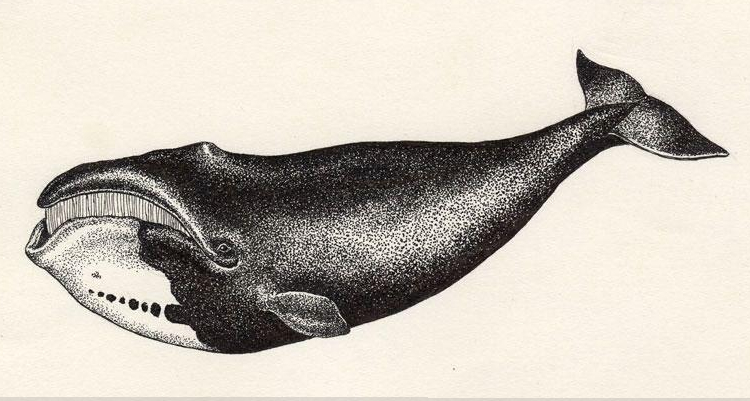
The Greenland Right Whale. As well as having a very thick layer of blubber under its skin the Right Whale had long strands of valuable "whalebone" in its mouth. This whalebone, which was made from the same material as our finger nails, hung in long strands from its upper jaw and acted like a sieve when the whale swam through the water eating its favourite food, tiny prawn like animals called krill. Whalebone was very strong and bendy and was used for making all sorts of things from carriage springs to ladies corsets.
Catching A Whale
Once at the whaling grounds, several weeks after leaving port, the ships would patrol the edge of the ice floes in search of whales. A barrel was fitted to the top of the main mast called the "Crow's Nest." The watchman would climb to the barrel on a rope ladder and once inside, would scan the waters in search of whales.
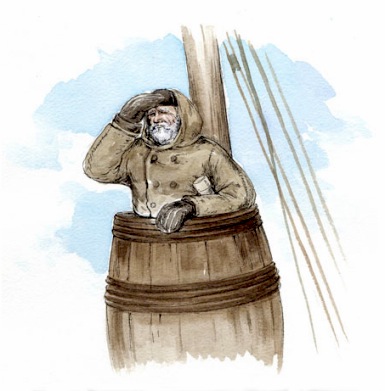
The watchman in the crow's nest keeps a look out for whales.
When a whale was sighted he would shout down to the crew on deck, "A fall! A fall!" The crew on duty would then rush to the whale boats which hung on ropes on both sides of the ship and lower them into the sea. Most ships carried about six whale boats, each manned with a crew of six oarsmen, a boat steerer and a harpooner. The oarsman nearest the bow of the boat would also act as line manager. It was his job to look after the long whaling line, a rope that was fixed to the harpoon, and make sure it didn't get caught or tangled when the harpoon was thrown or fired from a special gun, at the whale.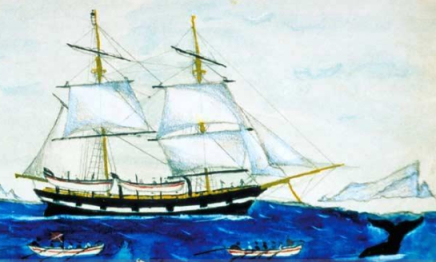
In this picture we see boats from the whaler "Lord Saltoun" chasing a whale. We can see the whale's tail as it is about to "sound" (dive) and try to escape from the hunters. It was painted by David Cardno, a whaler from Peterhead who first went sea as a stow away in 1867 when he was only 13 years old.
When the whale was caught it was towed back to the ship where it was "flensed." That was the word they used for cutting away the blubber. The blubber was hoisted onto the ship's deck where it was put into barrels and then stored away in the hold. What was left of the whale was known to whalers as "krang" and it was left in the water to provide the gulls and other seabirds with a rare feast.
The Voyage Home
When the Captain decided he had enough blubber aboard he set sail for home. On a successful trip this would mean returning "full ship." But not all trips were a success. Some ships were lost, sinking after being "nipped" or trapped in the ice while others might come home "clean" having missed the seals and had no luck at all at the whaling. Once back in Peterhead the barrels of blubber were unloaded onto the quayside on Keith Inch, the island that formed the east side of the harbour. The blubber was then taken to the boilyards where it was boiled to seperate the oil from the blubber. The men would then go to see the Captain who would sign them off with a conduct report and give them their wages and their share of the oil money.
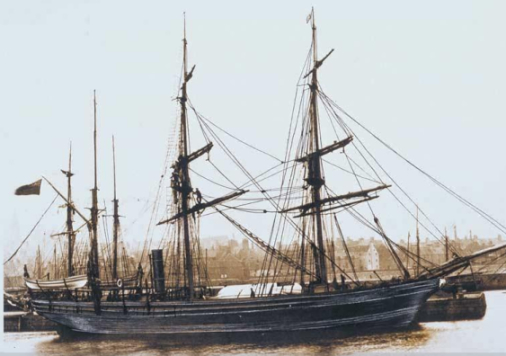
The "Windward", one of Peterhead's most famous whaling ships and the last to sail from the port. She was built in Peterhead in 1860 and ended her whaling career there in 1893.

